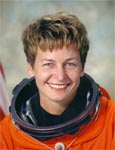
Lyndon B. Johnson Space Center
Houston, Texas 77058

 |
National Aeronautics and Space Administration
Lyndon B. Johnson Space Center |
 |
Biographical Data |
||
Peggy A. Whitson (Ph.D.)
NASA ASTRONAUT
PERSONAL DATA: Born February 9, 1960 in Mt. Ayr, Iowa. Hometown is Beaconsfield, Iowa. Married to Clarence F. Sams, Ph.D. She enjoys weight lifting, biking, basketball, and water skiing.
EDUCATION: Graduated from Mt. Ayr Community High School, Mt. Ayr, Iowa, in 1978; received a bachelor of science degree in biology/chemistry from Iowa Wesleyan College in 1981, and a doctorate in biochemistry from Rice University in 1985.
AWARDS/HONORS: NASA Outstanding Leadership Medal (2006); NASA Space Flight Medal (2002). Two patents approved (1997, 1998); Group Achievement Award for Shuttle-Mir Program (1996); American Astronautical Society Randolph Lovelace II Award (1995); NASA Tech Brief Award (1995); NASA Space Act Board Award (1995, 1998); NASA Silver Snoopy Award (1995); NASA Exceptional Service Medal (1995, 2003, 2006); NASA Space Act Award for Patent Application; NASA Certificate of Commendation (1994); Selected for Space Station Redesign Team (March-June 1993); NASA Sustained Superior Performance Award (1990); Krug International Merit Award (1989); NASA-JSC National Research Council Resident Research Associate (1986-1988); Robert A. Welch Postdoctoral Fellowship (1985-1986); Robert A. Welch Predoctoral Fellowship (1982-1985), Summa Cum Laude from Iowa Wesleyan College (1981); President’s Honor Roll (1978-81); Orange van Calhoun Scholarship (1980); State of Iowa Scholar (1979); Academic Excellence Award (1978).
EXPERIENCE: From 1981 to 1985, Whitson conducted her graduate work in biochemistry at Rice University, Houston, Texas, as a Robert A. Welch Predoctoral Fellow. Following completion of her graduate work she continued at Rice University as a Robert A Welch Postdoctoral Fellow until October 1986. Following this position, she began her studies at NASA Johnson Space Center, Houston, Texas, as a National Research Council Resident Research Associate. From April 1988 until September 1989, Whitson served as the Supervisor for the Biochemistry Research Group at KRUG International, a medical sciences contractor at NASA-JSC. In 1991-1997, Whitson was also invited to be an Adjunct Assistant Professor in the Department of Internal Medicine and Department of Human Biological Chemistry and Genetics at University of Texas Medical Branch, Galveston, Texas. In 1997, Whitson began a position as Adjunct Assistant Professor at Rice University in the Maybee Laboratory for Biochemical and Genetic Engineering.
NASA EXPERIENCE: From 1989 to 1993, Whitson worked as a Research Biochemist in the Biomedical Operations and Research Branch at NASA-JSC. From 1991-1993, she served as Technical Monitor of the Biochemistry Research Laboratories in the Biomedical Operations and Research Branch. From 1991-1992 she was the Payload Element Developer for Bone Cell Research Experiment (E10) aboard SL-J ( STS-47), and was a member of the US-USSR Joint Working Group in Space Medicine and Biology. In 1992, she was named the Project Scientist of the Shuttle-Mir Program ( STS-60, STS-63, STS-71, Mir 18, Mir 19) and served in this capacity until the conclusion of the Phase 1A Program in 1995. From 1993-1996 Whitson held the additional responsibilities of the Deputy Division Chief of the Medical Sciences Division at NASA-JSC. From 1995-1996 she served as Co-Chair of the U.S.-Russian Mission Science Working Group. In April 1996, she was selected as an astronaut candidate and started training, in August 1996. Upon completing two years of training and evaluation, she was assigned technical duties in the Astronaut Office Operations Planning Branch and served as the lead for the Crew Test Support Team in Russia from 1998-99. From November 2003 to March 2005 she served as Deputy Chief of the Astronaut Office. From Mar 2005-November 2005 she served as Chief of the Station Operations Branch, Astronaut Office. Whitson trained as the backup ISS Commander for Expedition 14 from November 2005-September 2006.
Whitson completed a six month tour of duty aboard the International Space Station as the ISS Commander for Expedition 16 in April 2008. This was Whitson’s second long-duration spaceflight. She has accumulated 377 days in space between the two missions, the most for any U.S. astronaut and 20th among all space veterans.
Whitson has performed a total of six career spacewalks, adding up to 39 hours, 46 minutes, more than any other woman.
SPACE FLIGHT EXPERIENCE: The Expedition-5 crew launched on June 5, 2002 aboard STS-111 and docked with the International Space Station on June 7, 2002. During her 6-month stay aboard the Space Station, Dr. Whitson installed the Mobile Base System, the S1 truss segment, and the P1 truss segment using the space station remote manipulator system, performed a 4 hour and 25 minute Orlan EVA to install micrometeoroid shielding on the Zvezda Service Module, and activated and checked out the Microgravity Sciences Glovebox, a facility class payload rack. She was named the first NASA Science Officer during her stay, and she conducted 21 investigations in human life sciences and microgravity sciences, as well as commercial payloads. The Expedition-5 crew (one American Astronaut and two Russian Cosmonauts) returned to Earth aboard STS-113 on December 7, 2002. Completing her first flight, Dr. Whitson logged 184 days, 22 hours and 14 minutes in space.
The Expedition-16 crew of Whitson and Cosmonaut Yuri Malenchenko launched on October 10, 2007 aboard a Soyuz TMA-11 spacecraft and docked with the International Space Station on October 12, 2007. During Expedition 16, as commander, Whitson oversaw the first expansion of the station's living and working space in more than six years. The station and visiting space shuttle crews added the Harmony connecting node, the European Space Agency's Columbus laboratory, the Japan Aerospace Exploration Agency’s Kibo logistics pressurized module and the Canadian Space Agency’s Dextre robot. Whitson performed five spacewalks to conduct assembly and maintenance tasks outside the complex. Whitson and Malenchenko undocked from the station and returned to Earth on April 19, 2008 aboard the Soyuz TMA-11 spacecraft. Whitson logged 192 days in space.
APRIL 2008